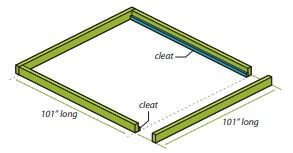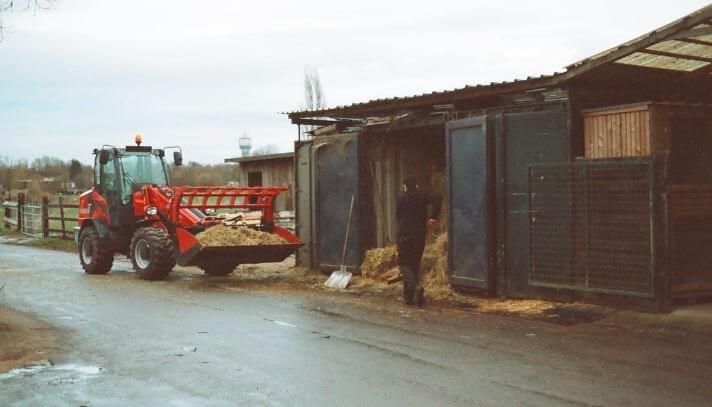Hay storage can be a challenge, especially if you live in a city or a congested area where you can’t build a barn. You can’t leave hay in the rain or snow because it will become moldy, posing gastrointestinal risks to your horse, rabbit, or cattle. This leaves you at crossroads wondering how to store hay without a barn.
If you don’t have a barn, you can store hay in a cattle panel hoop, Palleted hay shed, a garage, old refrigerators or freezers, and tarp top covers. These inexpensive hay storage ideas allow free circulation within your hay while preventing moisture and rodents that can cause decomposition.
In this article, I’ll take you through how to store hay without a barn. You’ll learn how to set up some of the best outdoor hay storage facilities. When you’re done reading, you’ll have a viable hay storage idea that will work for you.
The Different Ways to Store Hay Without a Barn
A barn is an essential commodity in every homestead that keeps animals like horses, rabbits, and cattle. Barns are excellent at storing hay and ensuring it does not become moldy.
It can be challenging to store hay without a barn or just a small amount of hay for rabbits. This explains why you need DIY horse storage ideas.
Feeding your animals moldy hay exposes them to gastrointestinal issues like diarrhea and bloating. Moldy hay is especially dangerous to horses as it causes mycotoxins and colic. Most horse owners struggle a lot with this condition.
So, what should you do if your situation does not allow you to have a barn?
The following are easy ways to store hay without a barn:
- Using a cattle panel coop
- In Palleted hay shed
- In a garage
- In tarp top covers
- Old refrigerator or freezer
- In ground covers
Using a Cattle Panel Hoop

A cattle panel hoop is a structure made of cattle panels bent side-by-side to form an arch. It’s basically an A-frame that has a tarp on top.
You can use this hay storage method by spreading the hay on wood pallets and covering it with a tarp. The tarp should have grommets that you can use to tie it down at the bottom of the structure.
This hay storage method is ideal if you have a small space and can’t build a shed. The tarp protects your hay from moisture, and the A-frame prevents rodents from getting to the hay.
How to Set Up a Cattle Panel Hay Storage Hoop
The table below shows the materials you need to set up a cattle panel hay storage hoop:
| Material | Quantity |
| Wood | 4 |
| Cattle panels | 2 |
| Furring strips | 2 |
| Deck screws | 1 lb |
| Hong rings | 1 box |
| Fender washers | 1 lb |
| Fence staples | 1 lb |
| Gate Latch | 1 |
| Door strap hinges | 2 |
| Tarps | 2 |
| Nylon rope | 30′ |
| Tie-down straps | As you want |
| Door | 1 |
Equipment Required
- Tape measure
- Pencil
- Hammer
- Electric screwdriver
- Wire cutters
- Pliers for hong rings
Procedure to Set up a Hay Storage Cattle Hoop
Step 1: Construct the Base Frame

The base frame has four pieces of wood on which the cattle panel will rest.
- Attach the cleats to two woods that will make the base frame.
- Screw the four pieces of wood together to form a rectangular or square shape as you wish.
- Attach wood pallets on the base to prevent hay from coming into contact with the ground.
Step 2: Hoop
- Take two cattle hoops and fold them into an arch.
- Use the fence staples to attach the folded panels to the base frame.
- Use hong rings to connect the panels
Step 3: Attach Frames on Both Ends for Strength
- Attach two 2×4 frames on each end of the structure. A door will be added on one end of your choosing.
- Use fence staples to secure the frames on the hoop
- Secure the frames by screwing them into the base frame
Step 4: Placing the Door
- Facemount the door on one side of the hoop. The door should be mounted on the frames you attached in step 3.
- After mounting the door, add a gate latch for locking your hoop.
Step 5: Use a Tarp to Cover the Hoop
- Place the tarp over the folded cattle panel. Screw the tarp onto the base frame all around.
- Use straps to tie the front of the tarp on the cattle panel
The video below demonstrates the above procedure:
Find Out: How to Charge a Kindle Paperwhite in 3 Easy Ways
Storing Hay in a Palleted Shed

Building a palleted hay shed is an excellent way to store square bales safely. A palleted hay shed is one of the inexpensive hay storage ideas that will not cost you much. It’s also a way of owning an outdoor storage facility, which makes it one of the best ideas on how to store hay without a barn.
You’ll need the following materials to build a palleted hay shed:
- 22 – 24 wood pallets
- Tarpaulins
- Hay
- Hammer
- Nails
- Tape measure
Before you embark on building a palleted hay shed, there are factors to consider for the safety of your hay.
Factors to Consider Before Building a Palleted Hay Shed
- The amount of hay: If you want to store loads of hay, you need a shed that can accommodate all the bales.
- The size of square bales: Not all hay comes in the same size; some could be larger than others. You may also get round bales of hay. You have to consider this when building your shed so that the hay will fit nicely.
- The location: The hay storage area must not be prone to flooding or too much moisture. It must also be bare ground.
- Climate: If you live in a rainy climate, the chances of mold forming on your new hay are high. In this case, you must place a thick tarp below the wooden pallets.
Procedure for Building a Palleted Hay Shed
- Choose a well-drained slope: You must set up your palleted hay shed in a sloppy ground that’s well-drained to prevent water from clogging and soaking your hay.
- Assemble the pallets by nailing them together: You can use as many pallets as you want, depending on the amount of hay you want to store.
- Lay a heavy-duty tarp on the ground: Placing a tarp on the ground first ensures that your hay will be safe even when it rains or snows excessively. If you can get an RV tarp, the better.
- Lay your clean, untreated wood pallets on the tarps: Ensure the pallets are clean with no mold or water.
- Add another tarp on top of the pallets: If you live in a rainy and snow area, you need another tarp on the pallets to minimize the amount of hay you’ll lose as they fall through the pallets. However, you can get away with this step if you live in a dry climate.
- Stack hay on top of the pallets: This is the final step where you stack hay on the prepared wooden pallet and cover it with another tarp. If you live in a windy area, place extra wood pallets on top to prevent the hay from blowing away.
Storing Hay in a Garage
If you have a garage and want to know how to store hay without a barn, this is the method for you. Although a garage is an excellent way to keep hay because it’s always dry, you must watch out for pets.
Due to harsh weather, rodents like rats and moles will most likely hide in the garage. Always check in the garage to ensure all is well with your hay.
Garages are excellent for storing hay in any shape, including the large round bales.
You’ll need:
- A garage
- Hay bales
- Tarpaulins
- A forklift or a hay elevator (optional)
Procedure for Storing Hay in a Garage
Step One: Choose the Right Garage
Not all garages are created equal, and some simply won’t do the job you need. Make sure your garage is big enough to store all your hay. The garage should also be free of water leaks and have good ventilation.
Step Two: Prepare the Garage
If there are any windows in the garage, cover them with tarpaulins or plywood to keep the hay from getting wet.
Step Three: Store the Hay
If you have a forklift or hay elevator, this is the time to use it. If not, you can store the hay by stacking them in a pyramid fashion. Make sure to leave enough space between the round bales and the walls for proper ventilation.
Once done stacking the hay, cover it with a tarp to keep moisture and pests away.
Storing Hay in an Old Refrigerator or Freezer
With the mention of a refrigerator and freezers, you may think this is a complicated process. But it’s pretty simple, and you only need an old fridge or freezer that’s not being used. This is also an excellent way to store large round bales of hay.
You’ll need:
- An old refrigerator or freezer
- Hay
- Tarpaulins
Follow the below procedure:
Step One: Prepare the Refrigerator or Freezer
Unplug the fridge or freezer and clean it out thoroughly. If there are any shelves in the fridge, remove them to get enough space.
Lay a clean and dry tarpaulin inside the refrigerator or freezer.
Step Two: Store the Hay
Place the hay inside the fridge or freezer and close the door. If you have a chest freezer, you can stack the hay on top of each other.
Cover the hay with another tarpaulin to keep them dry and protected from pests.
Storing Hay in Ground Covers
Storing hay in ground covers is one of the best outdoor hay storage ideas. However, it’s not just a matter of stacking your precious hay anywhere on the ground.
Consider the following factors before keeping hay in ground covers:
- The type of ground: The ground must be slopy and well-drained to prevent the hay from getting wet.
- The type of cover: The cover must be breathable to allow proper ventilation.
You’ll need:
- A clean and dry tarpaulin
- Hay
- A sloppy hay storage area
Procedure:
Step One: Choose the Right Ground
As mentioned above, the ground must be slopy and well-drained to store hay. The cover should also be large enough to store all the hay you have.
Step Two: Prepare the Ground and Store Your Hay
Clear the area of any debris and lay a clean and dry tarpaulin on the ground. You can put wooden pallets on the ground before adding the tarps. These pallets act as moisture barriers.
Place the hay on the tarps and cover them with another tarpaulin. You can weigh down the tarp’s edges with rocks or sandbags to keep it from blowing away.
Storing hay in ground is safe for all types of hay, including the square bales that might be hard to store in some areas. The ground also allows free air circulation in the hay.
Reasons to Take Good Care of Your Hay
Hay is an essential animal feed. The changing climate is causing longer winters and summers, which means most feeders are running out of hay. The situation is hitting horse owners hard because horses rely mostly on hay.
Paul McGill, the owner of a hay auction company in Lowa, confirms the shortage of hay supply by saying, “At the beginning of the summer drought, it didn’t hurt us too much. But the ranchers out there started thinking ahead, knowing they’d need the hay feed later; they held on to the hay they had. That started dwindling the hay that was coming to us in Iowa.”
Apart from the shortage of hay supply, another reason to keep hay properly is the risk of moldy hay to your animals. The most common risks of giving your animals hay with mold are:
Respiratory and Digestive Issues
Mold spores can cause respiratory problems in your animals. Inhaling mold spores can trigger allergies, asthma attacks, and heaves. Most horse owners are also worried about colic which is a major challenge.
According to the University of Nebraska, livestock may experience digestive issues such as diarrhea, vomiting, and bloating if they ingest hay with mold.
Weakened Immune System
Mold spores can weaken your animal’s immune system, making them more susceptible to diseases and infections.
Frequently Asked Questions
What is the best place to store hay safely?
The best place to store hay safely is one with sufficient ventilation and free of moisture. This is to prevent mold from your hay, so it remains healthy for your animals.
What is the best way to store bales of hay?
The best way to store bales of hay is to stack them in a clean and dry barn because moisture can’t penetrate through stacked hay easily. The barn must be free of roof leaks and storm runoffs that may lead to wet hay and mold formation. You must also be aware of pets and rodents that can destroy your hay in a barn.
Final Thoughts
So, there you have it; a guide on how to store hay without a barn. By following the tips in this article, you can rest assured that your hay will be well-protected from the elements and pests.
A key consideration is to choose a storage idea that fits the climate of your area, You don’t want to expose your expensive hay to wind and moisture as they will lead to a significant loss.







